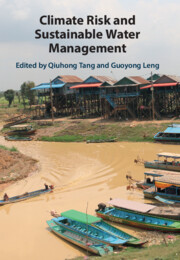Book contents
- Climate Risk and Sustainable Water Management
- Climate Risk and Sustainable Water Management
- Copyright page
- Contents
- Contributors
- Preface
- Acknowledgements
- Part I Water-Related Risks under Climate Change
- Part II Climate Risk to Human and Natural Systems
- 7 Observed Urban Effects on Temperature and Precipitation in Southeast China
- 8 Vegetation Dynamics, Land Use and Ecological Risk in Response to NDVI and Climate Change in Nepal
- 9 Climate Warming Induced Frozen Soil Changes and the Corresponding Environmental Effect on the Tibetan Plateau
- 10 A Review of the Effects of Climate Extremes on Agriculture Production
- 11 Agricultural Water Use Estimation and Impact Assessment on the Water System in China
- 12 Impact of Inter-Basin Water Transfer on Water Scarcity in Water-Receiving Area under Global Warming
- 13 Broadening and Deepening the Rainfall-Induced Landslide Detection
- 14 Estimating Aquifer Depth in Arid and Semi-arid Watersheds using Statistical Modelling of Spectral MODIS Products
- Part III Sustainable Water Management under Future Uncertainty
- Index
- References
8 - Vegetation Dynamics, Land Use and Ecological Risk in Response to NDVI and Climate Change in Nepal
from Part II - Climate Risk to Human and Natural Systems
Published online by Cambridge University Press: 17 March 2022
- Climate Risk and Sustainable Water Management
- Climate Risk and Sustainable Water Management
- Copyright page
- Contents
- Contributors
- Preface
- Acknowledgements
- Part I Water-Related Risks under Climate Change
- Part II Climate Risk to Human and Natural Systems
- 7 Observed Urban Effects on Temperature and Precipitation in Southeast China
- 8 Vegetation Dynamics, Land Use and Ecological Risk in Response to NDVI and Climate Change in Nepal
- 9 Climate Warming Induced Frozen Soil Changes and the Corresponding Environmental Effect on the Tibetan Plateau
- 10 A Review of the Effects of Climate Extremes on Agriculture Production
- 11 Agricultural Water Use Estimation and Impact Assessment on the Water System in China
- 12 Impact of Inter-Basin Water Transfer on Water Scarcity in Water-Receiving Area under Global Warming
- 13 Broadening and Deepening the Rainfall-Induced Landslide Detection
- 14 Estimating Aquifer Depth in Arid and Semi-arid Watersheds using Statistical Modelling of Spectral MODIS Products
- Part III Sustainable Water Management under Future Uncertainty
- Index
- References
Summary
Vegetation dynamics is a proxy indicator for environmental changes. The spatial and temporal evolution of the satellite derived normalized difference vegetation index (NDVI) is a useful tool to identify environmental risk at large spatial scales. This study aimed to find the vegetation dynamics, land use and ecological risk in Nepal. The NDVI from different satellite products, land use land cover (LULC) change, human footprint pressure (HFP) and climate (i.e., temperature and precipitation) were analysed. The result showed that NDVI has significantly increased with greening in large areas. Spatially, the decreased NDVI was more noticeable in the Trans-Himalayan region. Meanwhile, the spatially averaged temperature has significantly increased at the rate of 0.03°C yr-1 and precipitation decreased by 3.94 mm yr-1 during 1982–2015. The rapid change in climate, land uses and vegetation can alter the ecosystem. The lower temperature in the mountains is a limiting factor for vegetation. Meanwhile, the high temperature in Terai and low precipitation in western and far western regions with lower VCI enhance dryness. Thus, these regions are ecologically fragile. This study of vegetation dynamics, land use, climates and HFP indicates the level of ecological risk in Nepal.
- Type
- Chapter
- Information
- Climate Risk and Sustainable Water Management , pp. 160 - 178Publisher: Cambridge University PressPrint publication year: 2022

